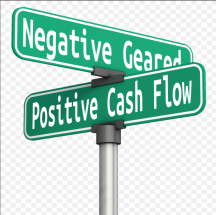The Truth About Cash Flow Positive Properties
In this blog we discuss the truth about cash flow properties. There is a school of thought promoting “cash -flow positive” properties. It stems from lower rental returns received after the fast-moving growth phase of the property cycle. When properties grow quickly in value, owners of existing properties are sometimes slow to move their rent up. This means new entrants into the market have to price their properties competitively, so rental returns suffer. If this is coupled with low interest rates, more people buy homes to live in, reducing the demand for rental properties and depressing prices.
However, this is cyclical and usually happens for 2-3 years out of a 10-year cycle. Eventually interest rates rise, owners start moving rents up and yield’s return. Inexperienced investors are unaware that rents will only be down for a couple of years. So, out of the closet and dusted off is the argument that buying positive cash flow property is better than sacrificing rental return for growth. This standard argument is that making money is better than losing money, and if you take it on face value we would all agree, but here’s the problem...
To find cash-flow positive property, typically you need to buy properties that are far away from capital cities. As the property cycle moves on, locations close to capital cities become less attractive in terms for rental yield and high rents start moving away from the city. I call it the “ripple effect” because it’s like ripples in a pond, moving away from the city.
Eventually to buy property that is going to be cash flow positive, you need to go further and further away from capital cities and therefore further away from the properties most likely to produce long term capital growth. So people chase the “ripple effect” and because they are rewarded with a cash flow and a growth boost, (even though it’s much less than what they could be getting), their strategy is validated.
The problem is that property in these country and marginal locations grows at a lower rate than their city counterparts.
This means that a property that is $1,000 cash flow positive now, might be $2,000 cash flow positive in 10 years. And a property in a prime location starts out cash flow negative, but ends up cash flow positive in 3-5 years, not to mention the value of this property could have almost doubled in value 10 years.
Sometimes I will hear the argument that if you have cash flow properties, you can buy unlimited amounts of property because the cash flow is always positive. Remember: You still need deposits to fund each property, and the bank will discount your rent by 20% and you still need to provide serviceability. And what if interest rates go up? There goes your cash flow and you are stuck with a property that has dubious capital growth.
Yes!. A property that gives you both is what you should aim for. They are out there, and with a bit of knowledge, research, perseverance, you can find them.
Over the past 25 years our clients have significantly increased their wealth, because they purchased properties i.e. houses, villa units and townhouses (NOT appartments) within a 10 km radius of the CBD and simply held them. Over time the loan to valuation ratios have lowered and rents increased, making their investments cash flow positive. I don't know a single wealthy person that owns a substantial amount of property in country towns. This is because they buy for long term capital growth and while they are interested in the returns on rentals, it is not their primary objective, because they know that over time, this will happen as values rise.














